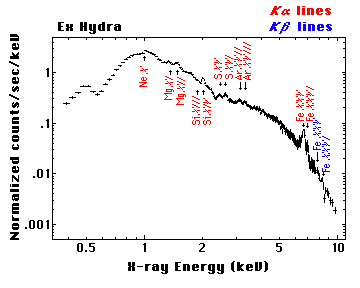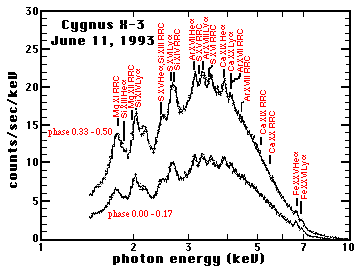ASCA Special Exhibit
Emission lines in accreting binaries
Accreting binary systems (Cataclysmic Variables and X-ray Binaries) are among the strongest sources of X-rays on the sky. These are binary systems of two stars where one is the corpse of a dead star that is pulling in matter from an ordinary companion star. Although their X-ray spectra had been studied before, ASCA offered a dramatic improvement in the spectral resolution, resulting in some interesting results. Here we share a couple of examples.

ASCA SIS spectrum of EX Hya showing emission lines of magnesium, silcon, sulfur, argon and iron. (Credit: Ishida et al 1994, PASJ 46, L81)
EX Hya is a cataclysmic variable with a magnetic white dwarf. In such a system, a white dwarf – a star that has exhausted most or all of its nuclear fuel and has collapsed to a very small size – is in orbit with an ordinary star. The white dwarf pulls matter from its companion. That gas is heated in a shock to ~100 million degrees K, before reaching the surface of the white dwarf. The gas emits X-rays, cools as it does so, and keeps radiating, cooling, and falling until it settles onto the white dwarf's surface. At that point, the temperature will have dropped to below ~1 million degrees K.
We expect the X-rays from these binary stars to be the sum of X-rays from the 100 million degree gas, the 10 million degree gas, the 1 million degree gas, and all the values in between – in other words, a continuous distribution of temperatures. However, before ASCA, we did not have any direct confirmation of this. The above spectrum, which shows emission lines of various elements, each from two different stages of ionization, provided the evidence: the ratio of lines conclusively proves that gas temperatures in the range ~10 to ~100 million co-exist in the X-ray emitting gas.

ASCA energy spectra of Cyg X-3 showing the presence of recombination continuum features. (Credit: Liedahl and Paerels, ApJL (1996) 468:L33)
There is another mechanism which can operate in X-ray binaries to create emission lines. This is called photoionization. If a cold gas is bombarded with X-rays from a nearby, hot source, these X-ray photons can knock off electrons from the atoms. Subsequently, the free electrons combine with the ions (atoms with a few electrons missing). Electrons orbiting in ions cannot have an arbitrary amount of energy (from the laws of quantum mechanics). That means that recombining electrons move from one discrete level to another, creating X-ray emission lines in the process.
When the X-ray astronomers first saw the above ASCA spectrum of Cyg X-3 (a particularly dramatic example of a photoionized plasma), they could identify many such lines, but they could not readily explain all of the observed features. Only later was it realized that this was the first observational evidence of 'recombination continuum' features (labeled RCC in the figure). Such lines are produced when the free electrons first combine with the ions (starting off with an arbitrary amount of energy but ending in one of the discrete levels), and appear "somewhat broader" than the emission lines.
Published: February 1998
Text Reviewed: September 2018


